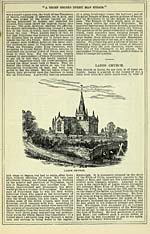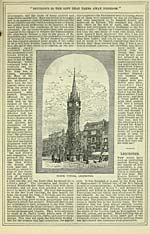Download files
Complete book:
Individual page:
Thumbnail gallery: Grid view | List view

1887 A PRI L 30 days.
CONSPIRATORS' CONFESSIONS— OLD ST. PAUL'S CBOSS.
3
s
4
M
«;
Tu
6
W
7
Th
8
F
9
S
10
s
ii
M
12
Tu
13
W
14
Th
M
F
16
S
17
s
iS
M
19
Tu
20
W
21
Th
22
F
23
S
s
M
Tu
W
Th
F
S
All Fools' Bay.— Prince Bismarck b.
1815.
Richard Cobden died, 1865.
Palm Sunday.
Oliver Goldsmith died, 177^.
Funeral of the Duke of Albany, 1884.
George Washing-ton, first President
U.S.A., 1789.
Wordsworth horn, 1770.
GOOD FRIDAY.
Lord Townshend dismissed from the
Lord Lieutenancy of Ireland, 1717.
Easter Sunday.
EASTER MONDA Y. BANK HOLIDAY.
Five-pound Bank-notes first issued,
1793.
Frederick I. fBarbarossa) caused the
crown of Lombardy to be placed on
his head, 1155.
First Prince of Wales horn, 1284.
Battle of Culloden, 1746.— Grattan's
motion for Irish Indepen.carr., 1782.
Low Sunday.
Justus Liebig (chemist) died, 1873.
Lord Beaconsfleld died, 1881— Grat-
tan's famous demand in Parliament
for Irish Independence, 1780.
Garibaldi having entered London on
the 11th of the month, received the
Freedom of the City, 1864.
St. George's Day.
2nd Sunday after Easter.
St. Mark.
Septennial Act passed, 1716.
Lord Shaftesbury born, 1801.
"A kindlier gentleman trod not the
earth," Merch. of Venice.
Royal proclamation against
" Hell-fire Club," 1720.
the
EXG.
Soot.
A 8 -2
'a £
S,<
6 35s
6 56s
11
5 3Cr
5 35r
12
6 39s
7 Os
13
5 25r
5 30r
14
8 42s
7 4s
O
5 21r
5 25r
16
6 45s
7 8s
17
5 16r
5 20r
18
6 49s
7 12s
19
5 12r
5 15r
20
6 52s
7 16s
21
5 8r
5 lOr
<i
6 56s
7 20s
23
5 3r
5 5r
24
6 59s
7 24s
25
4 59r
5 Or
26
7 2s
7 28s
27
4 55r
4 55r
28
7 5s
7 32s
29
4 51r
4 51r
©
7 9s
7 36s
1
4 47r
4 45r
2
7 12s
7 40s
3
4 43r
4 39r
4
7 15s
7 43s
5
4 39r
4 35r
6
7 18s
7 47s
)!
TEE MOON'S CHANGES.
First Quar. 1st, ..58 rain, past 1 after.
Full Moon 8th, ..39 min. past 5 morn.
Last Quar. 15th,.. 4 min. past 4 morn.
New Moon 23rd,.. 53 min. past 8 morn.
First Quar. 30th,-. min. past 11 after.
^Reference to Illustration.
THEB.B is probably no conspiracy in
the history of the sixteenth cen-
tury which can be regarded as more re-
markable than that of the " Holy Maid
of Kent" and her numerous accomplices.
Elizabeth Barton lived at the house
of Thomas Cobbe, in the parish of Ald-
ington, in Kent, and happening to be
visited with sickness by which her brain
became weakened, she had many epilep-
tic seizures. In her trances she saw
visions and uttered words and prophe-
cies having connection with King Henry
VIII. 's endeavour to divorce Queen
Catherine. She confided these to her
parish priest, Richard Masters, who
made them known to Dr. Bockling, a
canon of Canterbury, through whom
they became widely known, and were
everywhere proclaimed to he Divine
revelations, and she obtained the de-
scription of the " Holy Maid of Kent."
Though she recovered her perfect health
" by diet and physic, and by the course
of nature, which expelled the matter,
being the cause of her sickness," yet,
"by the counsel and confederacy of Dr.
Bockling and Richard Masters," she did
"falsely practise, use, and show unto the
people diverse and miraculous sundry
alterations of her sensible parts of her
body, craftily uttering in her said
feigned and false trances divers and
many virtuous and holy words tending
to the rebuke of sin, and in reproving of
such new opinions as then began to
spring in this realm." By these arts she
was made the instrument of stirring the
people of England against the divorce
of Catherine by Henry. The .chapel of
Aldington became the centre of many
CONSPIRATORS' CONFESSIONS— OLD ST. PAUL'S CBOSS.
3
s
4
M
«;
Tu
6
W
7
Th
8
F
9
S
10
s
ii
M
12
Tu
13
W
14
Th
M
F
16
S
17
s
iS
M
19
Tu
20
W
21
Th
22
F
23
S
s
M
Tu
W
Th
F
S
All Fools' Bay.— Prince Bismarck b.
1815.
Richard Cobden died, 1865.
Palm Sunday.
Oliver Goldsmith died, 177^.
Funeral of the Duke of Albany, 1884.
George Washing-ton, first President
U.S.A., 1789.
Wordsworth horn, 1770.
GOOD FRIDAY.
Lord Townshend dismissed from the
Lord Lieutenancy of Ireland, 1717.
Easter Sunday.
EASTER MONDA Y. BANK HOLIDAY.
Five-pound Bank-notes first issued,
1793.
Frederick I. fBarbarossa) caused the
crown of Lombardy to be placed on
his head, 1155.
First Prince of Wales horn, 1284.
Battle of Culloden, 1746.— Grattan's
motion for Irish Indepen.carr., 1782.
Low Sunday.
Justus Liebig (chemist) died, 1873.
Lord Beaconsfleld died, 1881— Grat-
tan's famous demand in Parliament
for Irish Independence, 1780.
Garibaldi having entered London on
the 11th of the month, received the
Freedom of the City, 1864.
St. George's Day.
2nd Sunday after Easter.
St. Mark.
Septennial Act passed, 1716.
Lord Shaftesbury born, 1801.
"A kindlier gentleman trod not the
earth," Merch. of Venice.
Royal proclamation against
" Hell-fire Club," 1720.
the
EXG.
Soot.
A 8 -2
'a £
S,<
6 35s
6 56s
11
5 3Cr
5 35r
12
6 39s
7 Os
13
5 25r
5 30r
14
8 42s
7 4s
O
5 21r
5 25r
16
6 45s
7 8s
17
5 16r
5 20r
18
6 49s
7 12s
19
5 12r
5 15r
20
6 52s
7 16s
21
5 8r
5 lOr
<i
6 56s
7 20s
23
5 3r
5 5r
24
6 59s
7 24s
25
4 59r
5 Or
26
7 2s
7 28s
27
4 55r
4 55r
28
7 5s
7 32s
29
4 51r
4 51r
©
7 9s
7 36s
1
4 47r
4 45r
2
7 12s
7 40s
3
4 43r
4 39r
4
7 15s
7 43s
5
4 39r
4 35r
6
7 18s
7 47s
)!
TEE MOON'S CHANGES.
First Quar. 1st, ..58 rain, past 1 after.
Full Moon 8th, ..39 min. past 5 morn.
Last Quar. 15th,.. 4 min. past 4 morn.
New Moon 23rd,.. 53 min. past 8 morn.
First Quar. 30th,-. min. past 11 after.
^Reference to Illustration.
THEB.B is probably no conspiracy in
the history of the sixteenth cen-
tury which can be regarded as more re-
markable than that of the " Holy Maid
of Kent" and her numerous accomplices.
Elizabeth Barton lived at the house
of Thomas Cobbe, in the parish of Ald-
ington, in Kent, and happening to be
visited with sickness by which her brain
became weakened, she had many epilep-
tic seizures. In her trances she saw
visions and uttered words and prophe-
cies having connection with King Henry
VIII. 's endeavour to divorce Queen
Catherine. She confided these to her
parish priest, Richard Masters, who
made them known to Dr. Bockling, a
canon of Canterbury, through whom
they became widely known, and were
everywhere proclaimed to he Divine
revelations, and she obtained the de-
scription of the " Holy Maid of Kent."
Though she recovered her perfect health
" by diet and physic, and by the course
of nature, which expelled the matter,
being the cause of her sickness," yet,
"by the counsel and confederacy of Dr.
Bockling and Richard Masters," she did
"falsely practise, use, and show unto the
people diverse and miraculous sundry
alterations of her sensible parts of her
body, craftily uttering in her said
feigned and false trances divers and
many virtuous and holy words tending
to the rebuke of sin, and in reproving of
such new opinions as then began to
spring in this realm." By these arts she
was made the instrument of stirring the
people of England against the divorce
of Catherine by Henry. The .chapel of
Aldington became the centre of many
Set display mode to: Large image | Transcription
Images and transcriptions on this page, including medium image downloads, may be used under the Creative Commons Attribution 4.0 International Licence unless otherwise stated. ![]()
| Scottish Post Office Directories > Towns > Forfar > Forfar directory and year book > 1887 > (96) |
|---|
| Permanent URL | https://digital.nls.uk/85364177 |
|---|
| Description | Forfar : W. Shepherd, 1884- |
|---|---|
| Description | Directories of individual Scottish towns and their suburbs. |
|---|
| Description | Around 700 Scottish directories published annually by the Post Office or private publishers between 1773 and 1911. Most of Scotland covered, with a focus on Edinburgh, Glasgow, Dundee and Aberdeen. Most volumes include a general directory (A-Z by surname), street directory (A-Z by street) and trade directory (A-Z by trade). |
|---|


